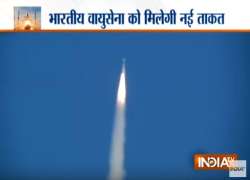ISRO successfully launches military communication satellite GSAT-7 from Sriharikota
GSLV-F11 is ISRO's fourth generation launch vehicle with three stages.

Military Communication satellite GSAT-7A on-board GSLV-F11 was launched at Satish Dhawan Space Centre in Sriharikota on Wednesday afternoon. The mission life of the GSAT-7A, built by the Indian Space Research Organisation, is eight years. It will provide communication capability to users in Ku-band over the Indian region, the space agency said.
GSAT-7 will boost the communication capabilities of defence forces, especially the Indian Air Force (IAF).
At 4.10 p.m. the Geosynchronous Satellite Launch Vehicle Mark II, numbered GSLV-F11, by the Indian space agency, rose into the sky with a deep-throated growl, breaking free of its shackles.
"The 26-hour countdown has commenced at 2.10 pm (IST) for the launch of communication satellite GSAT-7A onboard GSLV-F11 at Satish Dhawan Space Centre in Sriharikota. Lift-off scheduled at 4.10 pm tomorrow," ISRO said on Tuesday.
The GSLV-F11 will inject GSAT-7A into a Geosynchronous Transfer Orbit (GTO) and it will be placed in its final Geostationary Orbit using the onboard propulsion systems.
GSLV-F11 is ISRO's fourth generation launch vehicle with three stages.
Watch: ISRO launches GSAT-7 from Sriharikota
The four liquid strap-ons and a solid rocket motor at the core form the first stage of the launch vehicle, while the second stage is equipped with high thrust engine using liquid fuel, the space agency said on its website.
The Cryogenic Upper Stage forms the third and final stage of the vehicle.
The seventh launch of 2018 from Sriharikota, it marks the 69th mission of GSLV-F11 for ISRO.
Meanwhile, Air Chief Marshal B S Dhanoa on Wednesday said that GSLV-7A would enhance the networking and communication capabilities of the Air Force.
"We have several platforms (aircrafts) which have capabilities of communication through satellite. The communication to the platform (aircrafts) through the satellite will be made possible with this launch," he told reporters.
(With inputs from agencies)